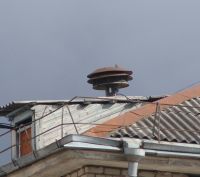Type S
- For the modern variations of Type S sirens, see Type S (disambiguation).
| Type S-28 (Тип С-28)
Type S-40 (Тип С-40) | |
 A Type S-40 on a building in Russia. Photo taken by Georg Pik on May 1st, 2013. | |
| Produced | ~1941-~1991 |
|---|---|
| Type | Omnidirectional Electromechanical |
| Frequency | 50 Hz |
| Voltage | 220/380 V AC 3 ph |
The Type S (Russian: Тип С) is a series of medium-sized electromechanical omnidirectional sirens that were the standard air raid siren models used in the Soviet Union. These sirens were likely introduced after 1941, following Nazi Germany's launch of Operation Barbarossa, a large-scale invasion of Soviet territories. The Type S sirens remained in use after World War II and throughout the Cold War, with standardized production ending in 1991. Today, these sirens are still sold by companies in Russia, Belarus, and Ukraine, although they have been updated since 1991, and the designs and specifications can vary by manufacturer. While they see limited use alongside extensive loudspeaker and siren networks in Russian cities, they can also be found in many post-Soviet states, although they are mostly replaced by newer siren models and systems.
Design
Type S-28

Type S-28 (Russian: Тип С-28) is the smaller of the 2 sirens and is/was primarily used for small-scale alerting in places where a much larger siren such as the Type S-40 would be unnecessary, like factories, warehouses, or other large indoor spaces. The Type S-28 is a very simple siren, only utilizing a 10-port rotor and stator (with a diameter of about 280 mm and height of about 110 mm)[1] above a 50 Hz 220/380 V 0.75 kW (1 hp) 3 ph motor[1] of varying manufacturer, as a result of siren construction being sourced from several companies during the Type S-28 siren's production span. The motor drives the rotor at about 2820-3000 rpm.[1] A metal mesh screen is wrapped around the stator to prevent debris from entering the rotor or injury from misuse of the siren. A rounded, ornate cover is placed directly above the stator, although lacks any mesh screen covering and would be inefficient from preventing rain from entering the rotor; this is why the Type S-28 was recommended for indoor spaces unlike the fully enclosed Type S-40. The entire assembly rests on a base (either flat or curved) of varying size with a flanged bottom; 3 holes on the base allow for the siren to be bolted to a flat surface. There are slight differences in construction depending on the manufacturer, but all sirens largely retain the same appearance. After standardized production ended in 1991, manufacturers modified the design of their Type S-28 sirens, making changes to the motor, rotor and stator design, mounting configuration, and methods of weatherproofing among others; very few have retained the design of the Type S-28 as it was upon introduction. The Type S-28 is about 430 mm in diameter and about 325 mm in height[1] has a net weight of around 18 kg.[1] The Type S-28 is 90 dBa at 1 m (3.2 ft) and has an operating temperature range of -40/45°C (-40°F) to +40°C (+104°F), with relative humidity up to 80%.[1] There are far more Type S-28 sirens in private possession today compared to the Type S-40, due to the former's smaller size and less permanence of installations.
Type S-40

Type S-40 (Russian: Тип С-40) is the larger of the 2 sirens and is/was primarily used for large-scale alerting in places where a much smaller siren such as the Type S-28 would be inefficient, like cities, villages, or other large outdoor spaces. The Type S-40 is a very simple siren, only utilizing a 10-port rotor and stator (with a diameter of about 440 mm and height of about 110 mm)[2] above a 50 Hz 220/380 V 3 kW (4 hp) 3 ph motor[2] of varying manufacturer, as a result of siren construction being sourced from several companies during the Type S-40 siren's production span. The motor drives the rotor at about 2820-3000 rpm.[2] 2 louvers are bolted to the top (larger in diameter) and bottom (smaller in diameter) of the stator, and a metal mesh screen is bolted to both and circles around the stator to prevent debris from entering the rotor or injury from misuse of the siren. 5 struts bolted to the top of the rotor support a rain shield (identical in diameter as the top louver) with a flattened top. Metal mesh screen wraps around the struts and the assembly serves as an air intake for the rotor. 2 eyebolts are bolted to opposing ends of the top of the rain shield, allowing for ease of installation or removal. The entire assembly rests on a base (either flat or curved) of varying size with a flanged bottom; 3 holes on the base allow for the siren to be bolted to a flat surface. There are slight differences in construction depending on the manufacturer, but all sirens largely retain the same appearance. After standardized production ended in 1991, manufacturers modified the design of their Type S-40 sirens, making changes to the motor, rotor and stator design, mounting configuration, and methods of weatherproofing among others; very few have retained the design of the Type S-40 as it was upon introduction. The Type S-40 is about 575 mm in diameter and about 740 mm in height[2] and has a net weight of around 65 kg.[2] The Type S-40 is 120 dBa at 1 m (3.2 ft) and has an operating temperature range of -40/45°C (-40°F) to +40°C (+104°F), with relative humidity up to 80%.[2] There are far less Type S-40 sirens in private possession today compared to the Type S-28, due to the former's larger size and more permanence of installations.